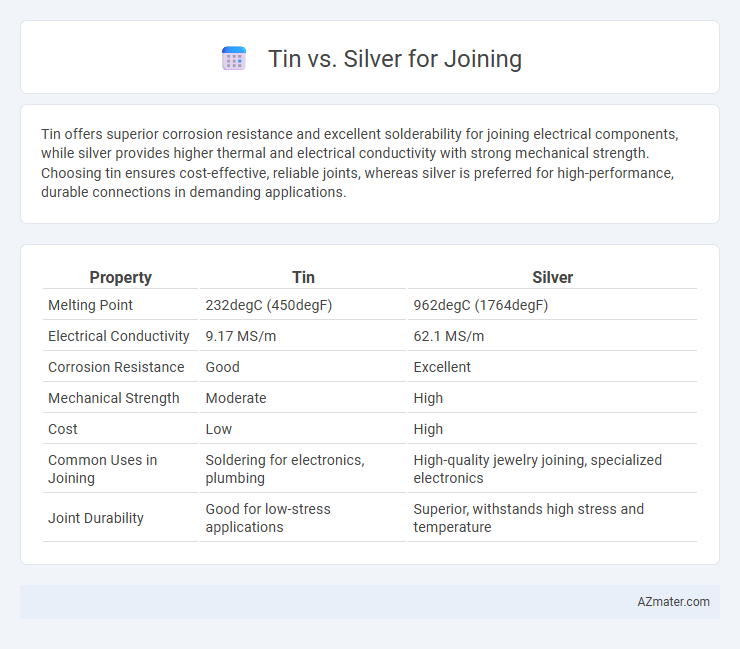Tin offers superior corrosion resistance and excellent solderability for joining electrical components, while silver provides higher thermal and electrical conductivity with strong mechanical strength. Choosing tin ensures cost-effective, reliable joints, whereas silver is preferred for high-performance, durable connections in demanding applications.
Table of Comparison
| Property | Tin | Silver |
|---|---|---|
| Melting Point | 232degC (450degF) | 962degC (1764degF) |
| Electrical Conductivity | 9.17 MS/m | 62.1 MS/m |
| Corrosion Resistance | Good | Excellent |
| Mechanical Strength | Moderate | High |
| Cost | Low | High |
| Common Uses in Joining | Soldering for electronics, plumbing | High-quality jewelry joining, specialized electronics |
| Joint Durability | Good for low-stress applications | Superior, withstands high stress and temperature |
Introduction to Metal Joining Techniques
Tin and silver are widely used metals in joining techniques due to their excellent mechanical properties and conductivity. Tin is commonly employed in soldering for its low melting point and strong wetting ability, making it ideal for delicate electronic assemblies. Silver offers superior thermal and electrical conductivity, often used in brazing and high-strength joints where durability and corrosion resistance are critical.
Overview of Tin and Silver as Soldering Materials
Tin, widely used in soldering, offers excellent wetting properties, corrosion resistance, and affordability, making it ideal for most electronic and plumbing applications. Silver solder, containing higher silver content, provides superior mechanical strength, higher melting points, and enhanced electrical conductivity, often preferred in high-performance or precision joints. Both materials contribute distinct advantages, with tin ensuring ease of use and cost-efficiency, while silver delivers durability and reliability in demanding environments.
Physical and Chemical Properties Comparison
Tin exhibits a lower melting point of approximately 232degC compared to silver's 962degC, making it suitable for low-temperature soldering applications. Chemically, tin forms stable, corrosion-resistant intermetallic compounds, while silver is highly conductive and resists oxidation, enhancing joint electrical performance. Physically, silver's superior tensile strength and ductility enable stronger mechanical bonds, whereas tin's softness allows better wetting and flow during the joining process.
Melting Points: Tin vs Silver
Tin has a melting point of 232degC (449.6degF), making it ideal for low-temperature soldering applications. Silver melts at a significantly higher temperature of 962degC (1763.6degF), which can limit its use in delicate electronic components due to heat sensitivity. The lower melting point of tin enables easier and safer joining processes compared to silver, especially in electronics and plumbing.
Electrical Conductivity Differences
Tin and silver differ significantly in electrical conductivity, with silver having a conductivity of approximately 63 x 10^6 S/m, making it the most conductive metal commonly used for joining applications. Tin, by comparison, has a much lower conductivity of around 9 x 10^6 S/m, which impacts its performance in electrical connections where minimal resistance is critical. These conductivity differences influence the choice of materials in soldering and plating, where silver ensures superior current flow while tin offers cost-effective corrosion resistance and mechanical strength.
Durability and Corrosion Resistance
Tin offers excellent corrosion resistance due to its ability to form a protective oxide layer, making it highly durable for solder joints in electronics and plumbing. Silver, while more expensive, provides superior mechanical strength and enhanced durability in high-stress applications, resisting wear and maintaining conductivity over time. Choosing between tin and silver for joining depends on the specific environmental conditions and mechanical demands, with silver generally preferred for long-lasting, high-performance connections.
Cost and Availability Analysis
Tin is significantly more cost-effective than silver, making it the preferred choice for budget-sensitive soldering applications. Its abundant global supply ensures consistent availability, reducing procurement delays. Silver, although offering superior mechanical and electrical properties, commands a higher price and faces occasional supply constraints due to limited mining sources.
Applications in Electronics and Industry
Tin offers excellent soldering properties with low melting point and strong wetting ability, making it ideal for electronic circuit board assembly and surface-mount technology. Silver provides superior electrical conductivity and mechanical strength, often used in high-performance industrial contacts, connectors, and specialized electronic components exposed to extreme conditions. Combining tin and silver alloys enhances joint reliability in electronics and industrial applications requiring durable, conductive, and corrosion-resistant connections.
Health, Safety, and Environmental Concerns
Tin offers superior safety due to its nontoxic nature, making it ideal for soldering in electronics and food-related applications. Silver, while providing excellent joint strength and conductivity, poses health risks from exposure to fine particulate matter during soldering and requires careful ventilation. Environmentally, tin is more sustainable with lower mining impacts, whereas silver extraction involves more significant ecological disruption and resource consumption.
Choosing the Right Metal for Your Project
Tin offers excellent corrosion resistance and is ideal for low-temperature soldering, providing strong joints in electrical and plumbing applications. Silver, while more expensive, delivers superior thermal conductivity and mechanical strength, making it suitable for high-stress or high-temperature environments. Selecting between tin and silver depends on factors such as operating temperature, mechanical load, and budget constraints to ensure reliable, long-lasting joints.

Infographic: Tin vs Silver for Joining
 azmater.com
azmater.com